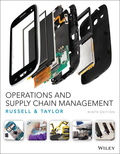
Concept explainers
Uber and the Sharing Economy
First there was Zipcar and BikeShare, where customers could conveniently rent a vehicle or bike near their home or place of work; then came Airbnb, Uber, and Snapgoods, where ordinary people could use their assets (homes, cars, household goods) to bring in extra cash. Now a full-blown sharing economy exists that supplies income to providers and new functionality to users (e.g., Dogvacy, TaskRabbit, Getaround, Lyft, LendingClub, Fon, and Turo).
Take Uber, for example, with its easy-to-use apps, quick service, and aff ordable prices. Uber acts as a broker, connecting people who need rides with people who can provide them. Add cool cars (UberBLACK and UberLUX), larger vehicles (UberSUV and UberHAUL), ride sharing (UberPOOL), and new modes of transportation (UberTAXI and UberCOPTER). Look for new logistical opportunities to deliver packages (UberRUSH), groceries (UberFRESH), and restaurant meals (UberEATS). Use Uber data to recommend services or activities, send messages or predict behavior, and when technology allows, send out an autonomous vehicle coordinated to a customer’s daily
Innovations such as shared services are transforming industries. It may seem simple for a company like Uber to establish an online marketplace where providers and customers match needs, but it can actually be quite complex. Companies that run this type of business are data- and technology-driven, and they are constantly looking for ways to use data to improve their services or gain a competitive edge. Operating in 330 cities and 59 countries, Uber’s one million active drivers transport millions of customers each day. Uber maintains a vast database on its drivers, wherever they are located, so that passengers can be matched quickly with available drivers. Data about passenger preferences is collected, too, for future use. And both the driver and the passenger can submit reviews of the service encounter.
Fares are calculated automatically, using GPS, street data and, of course, Uber’s own algorithms that make adjustments based on trip time (because time, not distance, drives fares) and other factors. “Surge pricing” kicks in during busy or difficult times to incentivize drivers to become active. Sometimes the results are extreme, as when one passenger paid $137 a mile on New Year’s Eve in New York City, or when a Washington, DC, passenger paid $640 for a $50 trip during a snowstorm. New York City has since negotiated a cap on surge pricing during inclement weather at 3.5 times the normal rate. In the meantime, Uber has applied for a patent on its special surge-pricing model.

The Uber phenomenon is changing the world of work. Discuss.
Want to see the full answer?
Check out a sample textbook solution
Chapter 5 Solutions
Operations and Supply Chain Management 9th edition
Additional Business Textbook Solutions
Business Essentials (12th Edition) (What's New in Intro to Business)
Corporate Finance (4th Edition) (Pearson Series in Finance) - Standalone book
Essentials of Corporate Finance (Mcgraw-hill/Irwin Series in Finance, Insurance, and Real Estate)
Marketing: An Introduction (13th Edition)
Foundations Of Finance
Financial Accounting: Tools for Business Decision Making, 8th Edition
- Use the internet to obtain crash safety ratings for passenger vehicles. Then, answer thesequestions:a. Which vehicles received the highest ratings? The lowest ratings?b. How important are crash-safety ratings to new car buyers? Does the degree of importancedepend on the circumstances of the buyer?c. Which types of buyers would you expect to be the most concerned with crash-safety ratings?d. Are there other features of a new car that might sway a buyer from focusing solely on crashsafety? If so, what might they be?arrow_forward“Implementing a Performance Management Communication Plan at Accounting, Inc.” Evaluate Accounting Inc.’s communication plan. Specifically, does it answer all of the questions that a good communication plan should answer? Which questions are left unanswered? How would you provide answers to the unanswered questions? “Implementing an Appeals Process at Accounting, Inc.” If you were to design an appeals process to handle these complaints well, what would be the appeal process? Describe the recommended process and why.arrow_forwardThe annual demand for water bottles at Mega Stores is 500 units, with an ordering cost of Rs. 200 per order. If the annual inventory holding cost is estimated to be 20%. of unit cost, how frequently should he replenish his stocks? Further, suppose the supplier offers him a discount on bulk ordering as given below. Can the manager reduce his costs by taking advantage of either of these discounts? Recommend the best ordering policy for the store. Order size Unit cost (Rs.) 1 – 49 pcs. 20.00 50 – 149 pcs. 19.50 150 – 299 pcs. 19.00 300 pcs. or more 18.00arrow_forward
- Help answer showing level work and formulasarrow_forwardI need to forecast using a 3-Period-Moving-Average-Monthly forecasting model which I did but then I need to use my forecast numbers to generate a Master Production Schedule (MPS) I have to Start with actual sales (my own test data numbers) for August-2022 Oct-2022 i need to create MPS to supply demand starting November-2022 April 2023 I just added numbers without applying formulas to the mps on the right side of the spreadsheet because I do not know how to do it. The second image is the example of what it should look like. Thank You.arrow_forwardSolve the following Question 1. How do volume and variety affect the process selection and layout types? Discuss 2. How is the human resource aspect important to operation function? Discuss 3. Discuss the supply network design and its impact on the overall performance of the organization.arrow_forward
- The supply chain is a conventional notion, but organizations are only really interested in making products that they can sell to customers. Provided they have reliable supplies of materials and reasonable transport for finished products, logistics is irrelevant. Do you think this is true? If yes, explain, and if no, clearly explain as well.arrow_forwardworking as a program operations managerarrow_forward12 X1, X230 1 x =0x2 write the Following linear Programming model by 1- general Form Canonical Forms Canonical formY 2- Standard Form Max Z=35X+ 4 X 2 +6 X3 ST. X+2X2-5x3 = 40 3X, + 6X2 + 7x 3 = 30 7x, +lox2 x3 = 50 X3 X 2 X 3 <0arrow_forward
 Practical Management ScienceOperations ManagementISBN:9781337406659Author:WINSTON, Wayne L.Publisher:Cengage,
Practical Management ScienceOperations ManagementISBN:9781337406659Author:WINSTON, Wayne L.Publisher:Cengage, Operations ManagementOperations ManagementISBN:9781259667473Author:William J StevensonPublisher:McGraw-Hill Education
Operations ManagementOperations ManagementISBN:9781259667473Author:William J StevensonPublisher:McGraw-Hill Education Operations and Supply Chain Management (Mcgraw-hi...Operations ManagementISBN:9781259666100Author:F. Robert Jacobs, Richard B ChasePublisher:McGraw-Hill Education
Operations and Supply Chain Management (Mcgraw-hi...Operations ManagementISBN:9781259666100Author:F. Robert Jacobs, Richard B ChasePublisher:McGraw-Hill Education
 Purchasing and Supply Chain ManagementOperations ManagementISBN:9781285869681Author:Robert M. Monczka, Robert B. Handfield, Larry C. Giunipero, James L. PattersonPublisher:Cengage Learning
Purchasing and Supply Chain ManagementOperations ManagementISBN:9781285869681Author:Robert M. Monczka, Robert B. Handfield, Larry C. Giunipero, James L. PattersonPublisher:Cengage Learning Production and Operations Analysis, Seventh Editi...Operations ManagementISBN:9781478623069Author:Steven Nahmias, Tava Lennon OlsenPublisher:Waveland Press, Inc.
Production and Operations Analysis, Seventh Editi...Operations ManagementISBN:9781478623069Author:Steven Nahmias, Tava Lennon OlsenPublisher:Waveland Press, Inc.





